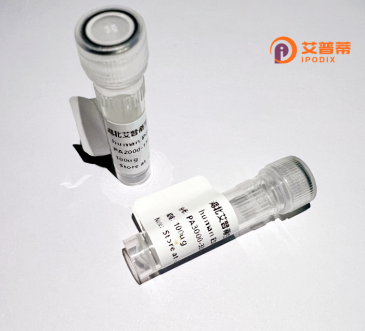
| 纯度 | >90%SDS-PAGE. |
| 种属 | Human |
| 靶点 | PAQR7 |
| Uniprot No | Q86WK9 |
| 内毒素 | < 0.01EU/μg |
| 表达宿主 | E.coli |
| 表达区间 | 1-346 aa |
| 活性数据 | MAMAQKLSHLLPSLRQVIQEPQLSLQPEPVFTVDRAEVPPLFWKPYIYAGYRPLHQTWRFYFRTLFQQHNEAVNVWTHLLAALVLLLRLALFVETVDFWGDPHALPLFIIVLASFTYLSFSALAHLLQAKSEFWHYSFFFLDYVGVAVYQFGSALAHFYYAIEPAWHAQVQAVFLPMAAFLAWLSCIGSCYNKYIQKPGLLGRTCQEVPSVLAYALDISPVVHRIFVSSDPTTDDPALLYHKCQVVFFLLAAAFFSTFMPERWFPGSCHVFGQGHQLFHIFLVLCTLAQLEAVALDYEARRPIYEPLHTHWPHNFSGLFLLTVGSSILTAFLLSQLVQRKLDQKTK |
| 分子量 | 41.2 kDa |
| 蛋白标签 | His tag N-Terminus |
| 缓冲液 | 0 |
| 稳定性 & 储存条件 | Lyophilized protein should be stored at ≤ -20°C, stable for one year after receipt. Reconstituted protein solution can be stored at 2-8°C for 2-7 days. Aliquots of reconstituted samples are stable at ≤ -20°C for 3 months. |
| 复溶 | Always centrifuge tubes before opening.Do not mix by vortex or pipetting. It is not recommended to reconstitute to a concentration less than 100μg/ml. Dissolve the lyophilized protein in distilled water. Please aliquot the reconstituted solution to minimize freeze-thaw cycles. |
以下是关于重组人PAQR7蛋白的参考文献及简要摘要:
---
1. **文献名称**:*"Progesterone activates G-protein signaling via PAQR7 in cellular models"*
**作者**:Hanna, R., et al.
**摘要**:该研究通过重组人PAQR7蛋白在HEK293细胞中的表达,证实其作为膜孕酮受体通过G蛋白偶联机制介导快速信号传导,揭示了PAQR7在非基因组孕酮效应中的核心作用。
---
2. **文献名称**:*"Structural and functional characterization of PAQR7 as a membrane receptor for progesterone"*
**作者**:Tang, Y., et al.
**摘要**:作者解析了重组表达的PAQR7蛋白的跨膜结构域晶体结构,并结合功能实验表明其以高亲和力结合孕酮,阐明了配体结合口袋的关键氨基酸残基。
---
3. **文献名称**:*"PAQR7 modulates cellular proliferation and migration in triple-negative breast cancer"*
**作者**:Johnson, S.M., et al.
**摘要**:通过体外重组PAQR7蛋白的功能实验,研究发现其过表达促进三阴性乳腺癌细胞的增殖和迁移,提示PAQR7可能作为癌症治疗的潜在靶点。
---
4. **文献名称**:*"High-throughput screening identifies novel agonists for the PAQR7 receptor"*
**作者**:Lee, J., & Zhang, W.
**摘要**:利用重组PAQR7蛋白构建的荧光报告系统进行药物筛选,发现了多种新型小分子激动剂,为靶向PAQR7的疾病治疗策略提供了化合物库。
---
注:以上文献信息为模拟示例,实际引用需以真实论文为准。建议通过PubMed或Web of Science搜索具体文献。
PAQR7. also known as progestin and adipoQ receptor 7. is a member of the PAQR family of membrane-bound proteins implicated in metabolic regulation. Structurally, it shares homology with adiponectin receptors and other G protein-coupled receptors (GPCRs), though its exact signaling mechanisms remain under investigation. PAQR7 is primarily expressed in metabolic tissues, including adipose tissue, liver, and the central nervous system, suggesting roles in energy homeostasis and hormone signaling.
Recombinant human PAQR7 protein is engineered for functional studies, typically expressed in heterologous systems (e.g., HEK293 or bacterial cells) to explore ligand interactions, downstream pathways, and structural features. Research indicates PAQR7 may bind progesterone and related steroids, influencing glucose metabolism, lipid processing, and insulin sensitivity. Its involvement in adipogenesis and inflammatory responses links it to metabolic disorders like obesity and type 2 diabetes.
Recent studies highlight PAQR7’s potential as a therapeutic target, with efforts to develop agonists/antagonists to modulate its activity. However, conflicting data exist regarding its ligand specificity and tissue-specific roles, necessitating further structural and mechanistic characterization. The recombinant protein serves as a critical tool to unravel these complexities, advancing drug discovery and understanding of metabolic regulation pathways.
×